Stage, television and film actress Deborah Kerr (1921-2007) was nicknamed 'The English Rose' for her fresh natural beauty. In many films, the Scottish-born film star played 'classic' English ladies, but during the 1950s she became known for her versatile roles in popular Hollywood productions.
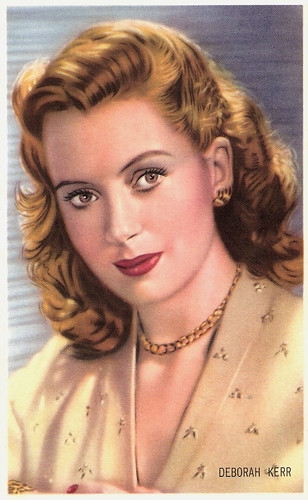
Belgian collectors card by Kwatta, Bois-d'Haine, no. C. 199. Photo: MGM.
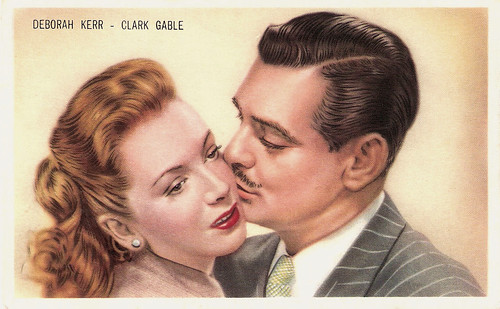
Belgian collectors card by Kwatta, Bois-d'Haine, no. C. 223. Photo: MGM. Publicity still for The Hucksters (Jack Conway, 1947) with Clark Gable.
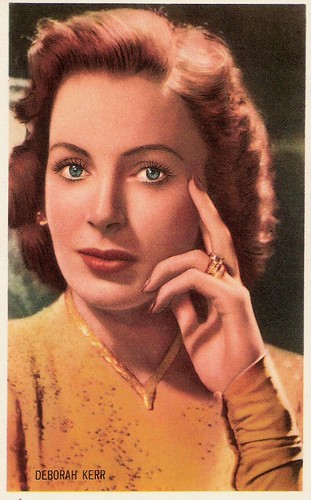
Belgian collectors card by Kwatta, Bois D'Haine, no. C. 252.
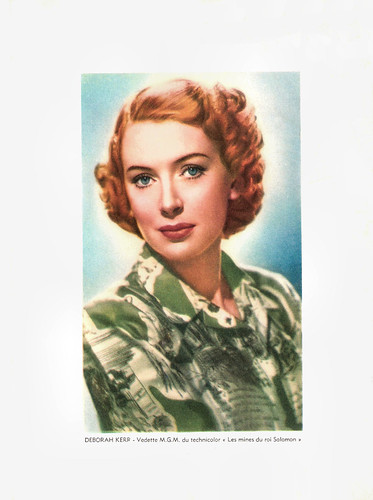
Belgian collectors card. Photo: MGM. Publicity still for King Solomon's Mines (Compton Bennett, Andrew Marton, 1950).
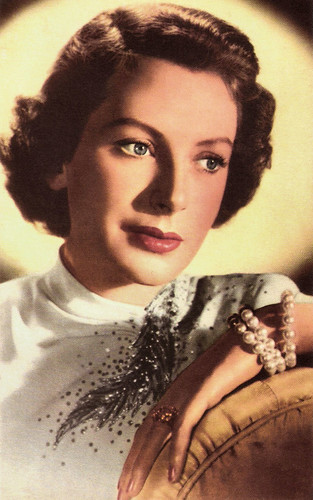
Belgian collectors card by Kwatta, Bois-d'Haine, no. C. 363. Photo: publicity still for The Prisoner of Zenda (Richard Thorpe, 1952).
Deborah Kerr was born as Deborah Jane Kerr-Trimmer in 1921, Helensburgh, Scotland. She was the daughter of Captain Arthur Kerr-Trimmer, a World War I veteran pilot, who became a naval architect and civil engineer, and his wife Kathleen Rose Smale.
A shy, insecure child, Deborah found an outlet for expressing her feelings in acting. Her aunt Phyllis Smale, a radio star and director of the Hicks-Smale Drama School in Bristol, became her first acting coach.
Her aunt got her some stage work when she was a teenager. Deborah first performed at the Open Air Theatre in Regent's Park, London. She subsequently performed with the Oxford Repertory Company in 1939-1940.
Her first appearance on the West End stage was as Ellie Dunn in Heartbreak House at the Cambridge Theatre in 1943.
She performed in France, Belgium and Holland with ENSA (Entertainments National Service Association, or Every Night Something Awful) - The British Army entertainment service.
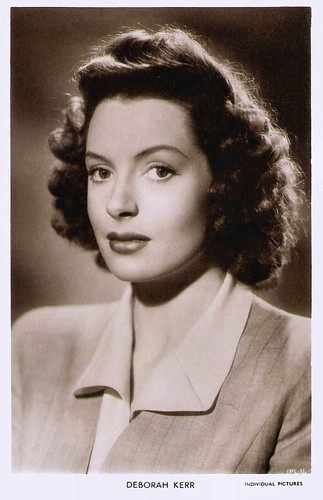
British postcard in the Picturegoer Series, no. W. 213. Photo: Individual Pictures. Publicity still for I See a Dark Stranger/The Adventuress (Frank Launder, 1946).
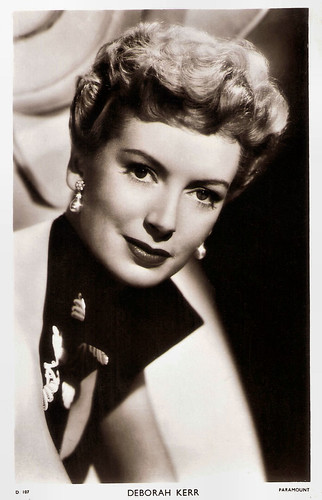
British postcard in the Picturegoer series, London, no. D 107. Photo: Paramount.
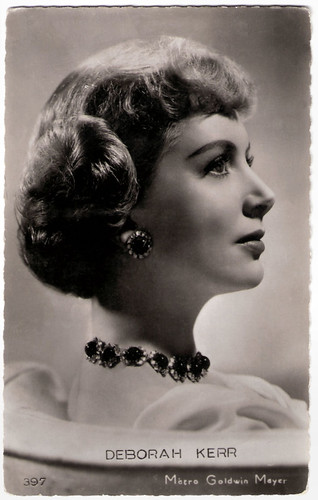
French postcard by Editions P.I., Paris, no. 397. Photo: Metro-Goldwyn-Mayer.
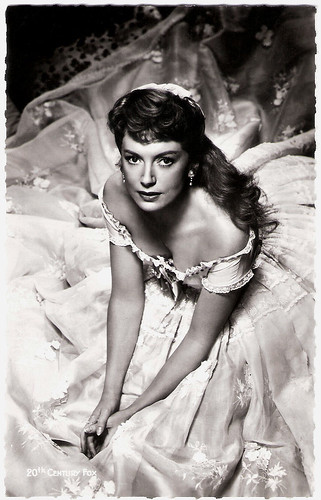
French postcard by Editions du Globe, no. 538. Photo: International Press.
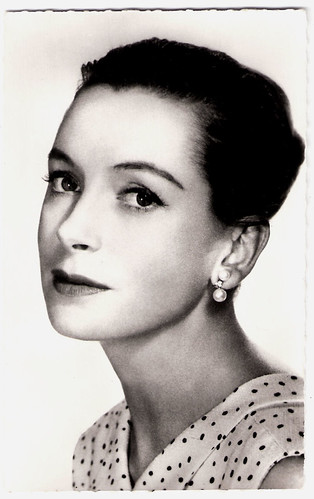
French postcard by Editions du Globe, Paris, no. 663.
Deborah Kerr's first film appearance was a small role in Contraband (Michael Powell, Emeric Pressburger, 1940), but her scenes were deleted.
British film producer Gabriel Pascal noticed and cast her in his film of George Bernard Shaw's Major Barbara (1941) as Jenny Hill, a girl of the salvation army.
Her wonderfully fresh natural beauty and incisiveness of playing were on show in Love on the Dole (John Baxter, 1941) and Hatter's Castle (Lance Comfort, 1941), in both as women who stumble sexually, by altruistic design in the former, through heartless seduction in the latter.
Michael Powell made her a major star of the British cinema by giving her the triple role of the hero’s three women in The Life and Death of Colonel Blimp (Michael Powell, Emeric Pressburger, 1943).
Next she played the dowdy wife who blossoms in wartime in Perfect Strangers (Alexander Korda, 1945), and the assertive Irish spy in I See a Dark Stranger (Frank Launder, 1946).
Then Powell cast her unforgettably as Sister Clodagh, forced to confront her own repressions in the Himalayan setting of Black Narcissus (Michael Powell, Emeric Pressburger, 1947). The film was a hit in the US as well as the UK, and Kerr won the New York Film Critics' Award as Actress of the Year.
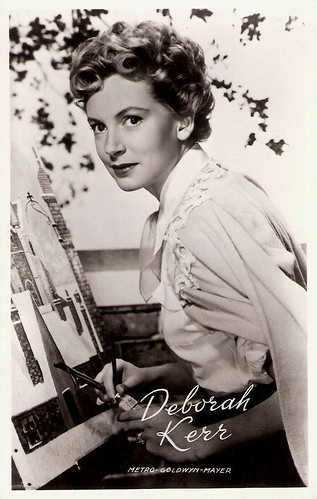
Dutch postcard by Takken, Utrecht, no. 960. Photo: Metro-Goldwyn-Mayer.
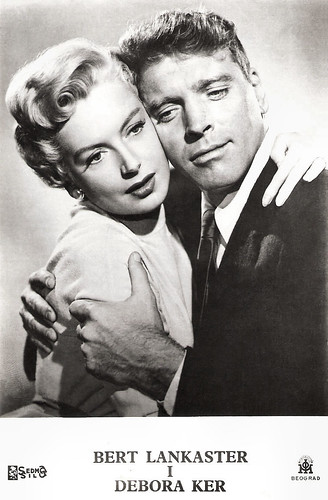
Yugoslavian postcard by IOM, Beograd. Photo: Sedmo Silo. Deborah Kerr and Burt Lancaster in From Here to Eternity (Fred Zinnemann, 1953).
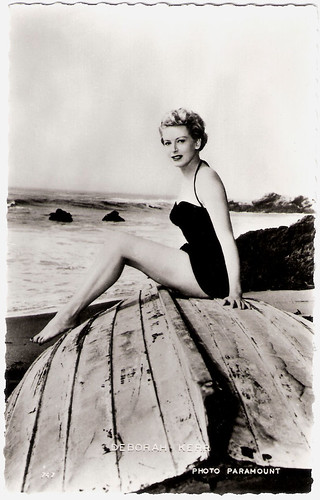
French postcard by Editions P.I., offered by Les Carbones Korès Carboplane, no. 747. Photo: Paramount.
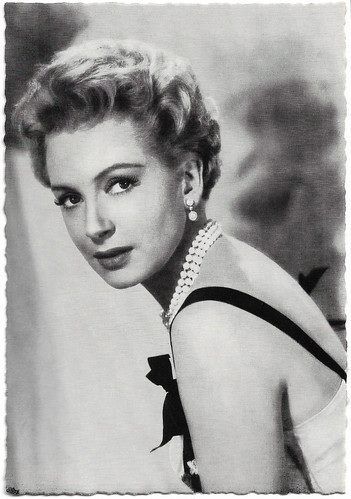
German postcard by WS-Druck, Wanne-Eickel, no. 279. Photo: Archiv Filmpress Zürich.
In 1947, Deborah Kerr went to Hollywood. Her surname was pronounced there as "car", not "kerr" In order to avoid confusion over pronunciation, Louis B. Mayer billed her as "Kerr rhymes with Star!"
She repeated for MGM her success in films like The Hucksters (Jack Conway, 1947) opposite Clark Gable, Edward, My Son (George Cukor, 1949) and the historical epic Quo Vadis (Mervyn Le Roy, 1951).
For her role as the wife who falls into dipsomania (a medical condition involving an uncontrollable craving for alcohol) in Edward, My Son, she was both nominated for a Golden Globe and an Academy Award, but won neither.
After a while she tired of playing prim-and-proper British ladies. “I came over here (Hollywood) to act, but it turned out all I had to do was to be high-minded, long suffering, white-gloved and decorative”, she was quoted.
Then came an opportunity to expand with From Here to Eternity (Fred Zinnemann, 1953). Originally Joan Crawford was meant to play the adulterous military wife who has an affair with Burt Lancaster, but when Crawford insisted on shooting the film with her own cameraman, the studio balked.
They decided to take a chance and cast Deborah Kerr, who made the most of the adulteress who makes love with Burt Lancaster on a Hawaii beach amidst the crashing waves. The casting worked, the film was a success, and Kerr received her second Oscar nomination.
And her career thereafter enjoyed a new, sexier versatility. She was quoted: “I don't think anyone knew I could act until I put on a bathing suit”.
In 1953, she also achieved success on the Broadway stage in Tea and Sympathy, reprising her role in the film version Tea and Sympathy (Vincente Minnelli, 1956).
That same year, she played one of her best-remembered screen roles, Mrs. Anna Leonowens in the Rodgers and Hammerstein musical The King and I (Walter Lang, 1956), although her singing voice in the film was dubbed by Marni Nixon.
More success followed in Heaven Knows, Mr. Allison (John Huston, 1957), An Affair to Remember (Leo McCarey. 1957) with Cary Grant, Separate Tables (Delbert Mann, 1958), The Sundowners (Fred Zinnemann, 1960), The Innocents (Jack Clayton, 1961) and The Night of the Iguana (John Huston, 1964).
Originally when filming began on Heaven Knows, Mr. Allison (1957), her co-star Robert Mitchum worried that Kerr would be like the prim characters she frequently played. However, after she swore at director John Huston during one take, Mitchum, who was in the water, almost drowned laughing. The two stars went on to have an enduring friendship which lasted until Mitchum's death in 1997.

British postcard on the Picturegoer Series, London, no. D 252. Photo: Metro-Goldwyn-Mayer. Publicity still for The Prisoner of Zenda (Richard Thorpe, 1952) with Stewart Granger.

British postcard in the Picturegoer Series, London, no. D 880. Photo: 20th Century Fox. Publicity still for The King and I (Walter Lang, 1956) with Yul Brynner.
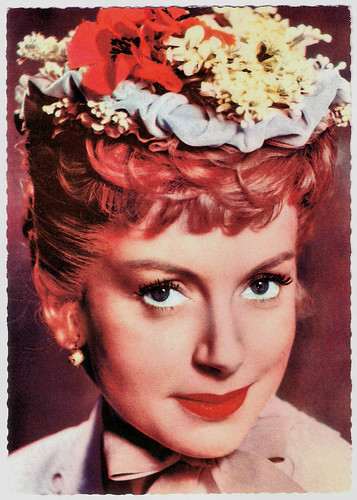
West-German postcard by ISV, no. A 55. Photo: 20th Century Fox. Publicity still for The King and I (Walter Lang, 1956).
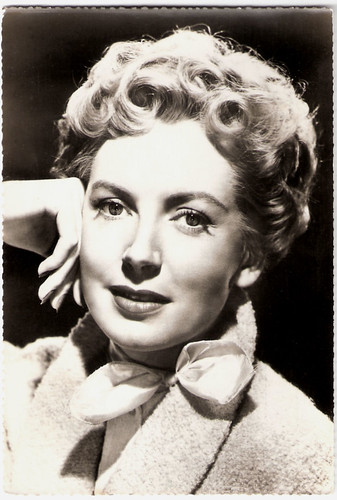
German postcard by WS-Druck, Wanne-Eickel, no. 279. Photo: Archiv Filmpress Zürich.
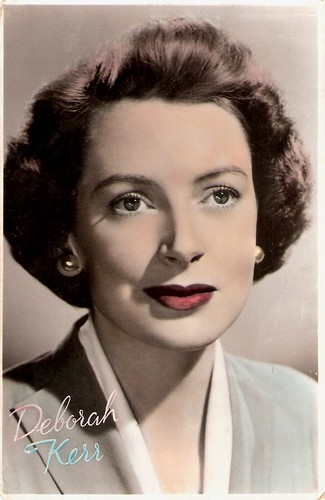
Dutch postcard. Photo: MGM.
In 1967, at the age of 46, Deborah Kerr starred in Casino Royale (Val Guest a.o., 1967), achieving the distinction of being the oldest 'Bond Girl' in any James Bond film.
In 1968, pressure of competition from younger, upcoming actresses made her agree to appear nude in John Frankenheimer's The Gypsy Moths, the only nude scene in her career. Then, in 1968, Deborah Kerr suddenly quit films, appalled by the explicit sex and violence of the day.
She did swan song performances as the prickly memsahib adjusting to the home counties in her last film, The Assam Garden (Mary McMurray, 1985), and as the older version of the female tycoon, Emma Harte, in the TV adaptation of Barbara Taylor Bradford's A Woman of Substance (Don Sharp, 1984). After Hold the Dream (Don Sharp, 1986), the two-part, four-hour followup to A Woman of Substance, she retired from acting altogether.
For her performance in A Woman of Substance, Kerr was nominated for an Emmy Award. In 1984, she was awarded a Cannes Film Festival Tribute. Deborah Kerr holds the record of the most Oscar nominations (six) without a win, but that was made up for in 1994, when she was given a Honorary Oscar for her screen achievements. It was to be her last public appearance.
Similar to her losing streak at the Oscars, Deborah was finally awarded a BAFTA Special Award in 1991 after being nominated four times. She did, however, win the New York Film Critics Award three times and the Golden Globe Award for The King and I (1956). She was made a Fellow of the British Film Institute in recognition of her outstanding contribution to film culture. And she was awarded a CBE (Commander of the Order of the British Empire) in the 1998.
Deborah Kerr died from complications from Parkinson's disease in 2007, in Botesdale, England. She lived in Switzerland and Spain after retiring from acting, but returned to England to be with her family when her Parkinson's disease worsened.
She was married twice. First to Royal Air Force squadron leader Anthony C. Bartley (1945-1959) with whom she had two daughters, Melanie Jane and Francesca Ann. In 1960, after her divorce, she married to Hollywood screenwriter Peter Viertel. The couple stayed together till her death. She is mother-in-law of actor John Shrapnel, who married her daughter Francesca. She is thus also the grandmother of writer Joe Shrapnel and actors Lex Shrapnel and Tom Shrapnel.
Scenes from The Life and Death of Colonel Blimp (1943). Source: The Film Foundation. The Life and Death of Colonel Blimp was restored by the Academy Film Archive in association with the BFI National Archive, ITV Studios Global Entertainment Ltd., and The Film Foundation. Powell and Pressburger’s magnificent epic was heavily cut for various reissues and even shown in black-and-white over the years, making it all the more vital that the film was restored in all its Technicolor glory.
Trailer for Black Narcissus (1947). Source: ryy79 (YouTube).
The famous scene on the beach in From Here to Eternity (1953). Source: Rowsdower ! (YouTube).
Trailer for The Innocents (1961). Source: PurpleGardenWalls (YouTube).
Sources: Brian McFarlane (Encyclopedia of British Film), Tommy Peter (IMDb), Steve Crook (IMDb), Wikipedia, and IMDb.

Belgian collectors card by Kwatta, Bois-d'Haine, no. C. 199. Photo: MGM.

Belgian collectors card by Kwatta, Bois-d'Haine, no. C. 223. Photo: MGM. Publicity still for The Hucksters (Jack Conway, 1947) with Clark Gable.

Belgian collectors card by Kwatta, Bois D'Haine, no. C. 252.

Belgian collectors card. Photo: MGM. Publicity still for King Solomon's Mines (Compton Bennett, Andrew Marton, 1950).

Belgian collectors card by Kwatta, Bois-d'Haine, no. C. 363. Photo: publicity still for The Prisoner of Zenda (Richard Thorpe, 1952).
Shy and Insecure Child
Deborah Kerr was born as Deborah Jane Kerr-Trimmer in 1921, Helensburgh, Scotland. She was the daughter of Captain Arthur Kerr-Trimmer, a World War I veteran pilot, who became a naval architect and civil engineer, and his wife Kathleen Rose Smale.
A shy, insecure child, Deborah found an outlet for expressing her feelings in acting. Her aunt Phyllis Smale, a radio star and director of the Hicks-Smale Drama School in Bristol, became her first acting coach.
Her aunt got her some stage work when she was a teenager. Deborah first performed at the Open Air Theatre in Regent's Park, London. She subsequently performed with the Oxford Repertory Company in 1939-1940.
Her first appearance on the West End stage was as Ellie Dunn in Heartbreak House at the Cambridge Theatre in 1943.
She performed in France, Belgium and Holland with ENSA (Entertainments National Service Association, or Every Night Something Awful) - The British Army entertainment service.

British postcard in the Picturegoer Series, no. W. 213. Photo: Individual Pictures. Publicity still for I See a Dark Stranger/The Adventuress (Frank Launder, 1946).

British postcard in the Picturegoer series, London, no. D 107. Photo: Paramount.

French postcard by Editions P.I., Paris, no. 397. Photo: Metro-Goldwyn-Mayer.

French postcard by Editions du Globe, no. 538. Photo: International Press.

French postcard by Editions du Globe, Paris, no. 663.
Women Who Stumble Sexually
Deborah Kerr's first film appearance was a small role in Contraband (Michael Powell, Emeric Pressburger, 1940), but her scenes were deleted.
British film producer Gabriel Pascal noticed and cast her in his film of George Bernard Shaw's Major Barbara (1941) as Jenny Hill, a girl of the salvation army.
Her wonderfully fresh natural beauty and incisiveness of playing were on show in Love on the Dole (John Baxter, 1941) and Hatter's Castle (Lance Comfort, 1941), in both as women who stumble sexually, by altruistic design in the former, through heartless seduction in the latter.
Michael Powell made her a major star of the British cinema by giving her the triple role of the hero’s three women in The Life and Death of Colonel Blimp (Michael Powell, Emeric Pressburger, 1943).
Next she played the dowdy wife who blossoms in wartime in Perfect Strangers (Alexander Korda, 1945), and the assertive Irish spy in I See a Dark Stranger (Frank Launder, 1946).
Then Powell cast her unforgettably as Sister Clodagh, forced to confront her own repressions in the Himalayan setting of Black Narcissus (Michael Powell, Emeric Pressburger, 1947). The film was a hit in the US as well as the UK, and Kerr won the New York Film Critics' Award as Actress of the Year.

Dutch postcard by Takken, Utrecht, no. 960. Photo: Metro-Goldwyn-Mayer.

Yugoslavian postcard by IOM, Beograd. Photo: Sedmo Silo. Deborah Kerr and Burt Lancaster in From Here to Eternity (Fred Zinnemann, 1953).

French postcard by Editions P.I., offered by Les Carbones Korès Carboplane, no. 747. Photo: Paramount.

German postcard by WS-Druck, Wanne-Eickel, no. 279. Photo: Archiv Filmpress Zürich.
Kerr rhymes with Star!
In 1947, Deborah Kerr went to Hollywood. Her surname was pronounced there as "car", not "kerr" In order to avoid confusion over pronunciation, Louis B. Mayer billed her as "Kerr rhymes with Star!"
She repeated for MGM her success in films like The Hucksters (Jack Conway, 1947) opposite Clark Gable, Edward, My Son (George Cukor, 1949) and the historical epic Quo Vadis (Mervyn Le Roy, 1951).
For her role as the wife who falls into dipsomania (a medical condition involving an uncontrollable craving for alcohol) in Edward, My Son, she was both nominated for a Golden Globe and an Academy Award, but won neither.
After a while she tired of playing prim-and-proper British ladies. “I came over here (Hollywood) to act, but it turned out all I had to do was to be high-minded, long suffering, white-gloved and decorative”, she was quoted.
Then came an opportunity to expand with From Here to Eternity (Fred Zinnemann, 1953). Originally Joan Crawford was meant to play the adulterous military wife who has an affair with Burt Lancaster, but when Crawford insisted on shooting the film with her own cameraman, the studio balked.
They decided to take a chance and cast Deborah Kerr, who made the most of the adulteress who makes love with Burt Lancaster on a Hawaii beach amidst the crashing waves. The casting worked, the film was a success, and Kerr received her second Oscar nomination.
And her career thereafter enjoyed a new, sexier versatility. She was quoted: “I don't think anyone knew I could act until I put on a bathing suit”.
In 1953, she also achieved success on the Broadway stage in Tea and Sympathy, reprising her role in the film version Tea and Sympathy (Vincente Minnelli, 1956).
That same year, she played one of her best-remembered screen roles, Mrs. Anna Leonowens in the Rodgers and Hammerstein musical The King and I (Walter Lang, 1956), although her singing voice in the film was dubbed by Marni Nixon.
More success followed in Heaven Knows, Mr. Allison (John Huston, 1957), An Affair to Remember (Leo McCarey. 1957) with Cary Grant, Separate Tables (Delbert Mann, 1958), The Sundowners (Fred Zinnemann, 1960), The Innocents (Jack Clayton, 1961) and The Night of the Iguana (John Huston, 1964).
Originally when filming began on Heaven Knows, Mr. Allison (1957), her co-star Robert Mitchum worried that Kerr would be like the prim characters she frequently played. However, after she swore at director John Huston during one take, Mitchum, who was in the water, almost drowned laughing. The two stars went on to have an enduring friendship which lasted until Mitchum's death in 1997.

British postcard on the Picturegoer Series, London, no. D 252. Photo: Metro-Goldwyn-Mayer. Publicity still for The Prisoner of Zenda (Richard Thorpe, 1952) with Stewart Granger.

British postcard in the Picturegoer Series, London, no. D 880. Photo: 20th Century Fox. Publicity still for The King and I (Walter Lang, 1956) with Yul Brynner.

West-German postcard by ISV, no. A 55. Photo: 20th Century Fox. Publicity still for The King and I (Walter Lang, 1956).

German postcard by WS-Druck, Wanne-Eickel, no. 279. Photo: Archiv Filmpress Zürich.

Dutch postcard. Photo: MGM.
The oldest 'Bond Girl'
In 1967, at the age of 46, Deborah Kerr starred in Casino Royale (Val Guest a.o., 1967), achieving the distinction of being the oldest 'Bond Girl' in any James Bond film.
In 1968, pressure of competition from younger, upcoming actresses made her agree to appear nude in John Frankenheimer's The Gypsy Moths, the only nude scene in her career. Then, in 1968, Deborah Kerr suddenly quit films, appalled by the explicit sex and violence of the day.
She did swan song performances as the prickly memsahib adjusting to the home counties in her last film, The Assam Garden (Mary McMurray, 1985), and as the older version of the female tycoon, Emma Harte, in the TV adaptation of Barbara Taylor Bradford's A Woman of Substance (Don Sharp, 1984). After Hold the Dream (Don Sharp, 1986), the two-part, four-hour followup to A Woman of Substance, she retired from acting altogether.
For her performance in A Woman of Substance, Kerr was nominated for an Emmy Award. In 1984, she was awarded a Cannes Film Festival Tribute. Deborah Kerr holds the record of the most Oscar nominations (six) without a win, but that was made up for in 1994, when she was given a Honorary Oscar for her screen achievements. It was to be her last public appearance.
Similar to her losing streak at the Oscars, Deborah was finally awarded a BAFTA Special Award in 1991 after being nominated four times. She did, however, win the New York Film Critics Award three times and the Golden Globe Award for The King and I (1956). She was made a Fellow of the British Film Institute in recognition of her outstanding contribution to film culture. And she was awarded a CBE (Commander of the Order of the British Empire) in the 1998.
Deborah Kerr died from complications from Parkinson's disease in 2007, in Botesdale, England. She lived in Switzerland and Spain after retiring from acting, but returned to England to be with her family when her Parkinson's disease worsened.
She was married twice. First to Royal Air Force squadron leader Anthony C. Bartley (1945-1959) with whom she had two daughters, Melanie Jane and Francesca Ann. In 1960, after her divorce, she married to Hollywood screenwriter Peter Viertel. The couple stayed together till her death. She is mother-in-law of actor John Shrapnel, who married her daughter Francesca. She is thus also the grandmother of writer Joe Shrapnel and actors Lex Shrapnel and Tom Shrapnel.
Scenes from The Life and Death of Colonel Blimp (1943). Source: The Film Foundation. The Life and Death of Colonel Blimp was restored by the Academy Film Archive in association with the BFI National Archive, ITV Studios Global Entertainment Ltd., and The Film Foundation. Powell and Pressburger’s magnificent epic was heavily cut for various reissues and even shown in black-and-white over the years, making it all the more vital that the film was restored in all its Technicolor glory.
Trailer for Black Narcissus (1947). Source: ryy79 (YouTube).
The famous scene on the beach in From Here to Eternity (1953). Source: Rowsdower ! (YouTube).
Trailer for The Innocents (1961). Source: PurpleGardenWalls (YouTube).
Sources: Brian McFarlane (Encyclopedia of British Film), Tommy Peter (IMDb), Steve Crook (IMDb), Wikipedia, and IMDb.
4 comments:
Thanks so much for this great bio on Deberah Kerr, I thoroughly enjoyed it. Looking forward to delving into your blog again soon, super.
Thanks, you're welcome. About Deborah Kerr I got a nice mail that it's typical that she was nicknamed 'The English Rose' while she was in fact Scottish. I guess that mail probably came from Scotland.
I suppose it's understandable that she became known as the English Rose as that was the image she adopted and projected on the screen. And I don't think she was ever taken seriously as Scottish for this reason and others. Yet notwithstanding that, there was something of the middle-class prudish Scottish schoolmistress to her appearance and demeanour that was unmistakeable and is certainly NOT common in English women. As an aside, Niven and Bogarde were typecast as English Gentlemen and neither had a drop of English blood in his veins - though they were both half-Scottish!
Would you be curious about exchanging links? online casino bonus
Post a Comment